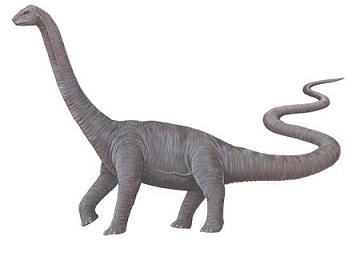
Rebbachisaurus is a fascinating genus of sauropod dinosaur that roamed the Earth during the Late Cretaceous period, approximately 95 to 70 million years ago. This enormous, long-necked herbivore belonged to the sauropod subgroup known as Rebbachisauridae, which is characterized by some distinctive features that set it apart from other sauropods. Here, we delve into the world of Rebbachisaurus and explore its remarkable traits, habitat, discovery, and its role in the complex tapestry of prehistoric life.
Rebbachisaurus was an immense dinosaur, rivaling the largest sauropods in size. Estimates suggest that it could reach lengths of up to 70-80 feet (21-24 meters) or more, with a towering neck and a relatively slender, elongated body. This massive size allowed it to access high vegetation in the ancient forests of its time.
| Name: | Rebbachisaurus dinosaurs |
| Size: | Around 70-80 feet (21-24 meters) in length. |
| Main Facts: | Rebbachisaurus, a gigantic sauropod, boasted a long neck for browsing high vegetation, contributing to Late Cretaceous ecosystem diversity. |
Its most distinctive feature was its long neck, a hallmark of all sauropods. While not as lengthy as the necks of some of its relatives like Brachiosaurus, Rebbachisaurus had an impressive neck, equipped with a series of elongated vertebrae. These neck adaptations allowed it to browse on vegetation that other herbivores could not reach, granting it access to a niche food source.

Rebbachisaurus was a herbivore, relying on a plant-based diet. It likely feasted on a variety of vegetation, including ferns, cycads, conifers, and other prehistoric plants that proliferated during the Late Cretaceous. Its unique neck structure made it well-suited to browse the treetops and gather food resources that were otherwise out of reach for many other dinosaurs.
Fossils of Rebbachisaurus have been unearthed in various locations, providing insights into its wide distribution during the Late Cretaceous. Notably, its remains have been discovered in North Africa, specifically Morocco, and South America, particularly in Argentina. The presence of Rebbachisaurus fossils in these distant regions suggests that it inhabited a range of environments, from coastal areas to inland regions, highlighting its adaptability to different ecosystems.
Rebbachisaurus was first scientifically described in the mid-20th century based on fossils found in Morocco. Since its initial discovery, additional fossils have been unearthed in various parts of Africa and South America. These discoveries have led to a better understanding of the dinosaur's morphology and distribution.
Classification-wise, Rebbachisaurus belongs to the Macronaria subgroup within the broader classification of sauropod dinosaurs. Within Macronaria, it is part of the rebbachisaurid subgroup, which includes other closely related long-necked dinosaurs. The study of its classification provides valuable insights into the evolutionary relationships among sauropods and their diversification during the Late Cretaceous.
Rebbachisaurus, like many other sauropods, is believed to have been a social animal that lived in herds. Its massive size would have provided some protection against predators, and the vast quantities of vegetation it consumed would have supported the dietary needs of a group of individuals.
In terms of locomotion, Rebbachisaurus was likely a slow-moving dinosaur due to its enormous size. Its long neck and body required significant energy to operate, and its quadrupedal stance with column-like legs was adapted for stability rather than speed.
Rebbachisaurus was a massive sauropod dinosaur from the Late Cretaceous, characterized by its colossal size, with estimates of up to 70-80 feet in length. Its most distinctive feature was its long neck, adorned with elongated vertebrae, allowing it to browse high vegetation. As a herbivore, it primarily consumed ferns, cycads, and conifers, using its unique neck adaptations to reach otherwise inaccessible plant material.
Fossils of Rebbachisaurus have been found in North Africa (Morocco) and South America (Argentina), showcasing its adaptability to diverse environments. This gentle giant played a vital role in Late Cretaceous ecosystems as one of the largest and most formidable herbivores.
Comparing Rebbachisaurus to other dinosaurs sheds light on its unique characteristics and its place in the dinosaur kingdom. Here, we'll compare Rebbachisaurus with some other notable dinosaurs :
Rebbachisaurus was a massive sauropod, similar in size to other large sauropods like Argentinosaurus and Patagotitan. It could reach lengths of around 70-80 feet, making it one of the giants of the Late Cretaceous.
While Rebbachisaurus had a long neck, it wasn't as long as some other sauropods like Brachiosaurus or Mamenchisaurus. Its neck was adapted for reaching high vegetation, but not to the same extreme as those dinosaurs.
Rebbachisaurus fossils have been found in both North Africa (Morocco) and South America (Argentina), demonstrating its adaptability to diverse environments. In contrast, some sauropods had more localized distributions.
Like many sauropods, Rebbachisaurus was a herbivore, specializing in consuming ferns, cycads, conifers, and other prehistoric plants. Its diet was similar to that of other large herbivorous dinosaurs.
Rebbachisaurus' fossils have been discovered on two continents, suggesting a broader geographic range compared to some dinosaurs that were more localized.
Rebbachisaurus belongs to the sauropod family, whereas other famous sauropods like Brachiosaurus or Apatosaurus belong to different genera within the same group.
Rebbachisaurus was first described scientifically in the mid-20th century, relatively recently compared to some other well-known dinosaurs like Tyrannosaurus rex or Triceratops.
Like many sauropods, Rebbachisaurus is believed to have been social animals, living in herds. This social behavior is shared with other sauropods, enhancing their protection against predators.
Rebbachisaurus, like most dinosaurs, went extinct at the end of the Cretaceous period, around 65 million years ago, possibly due to catastrophic events like the asteroid impact. Its extinction mirrors that of other dinosaur groups.